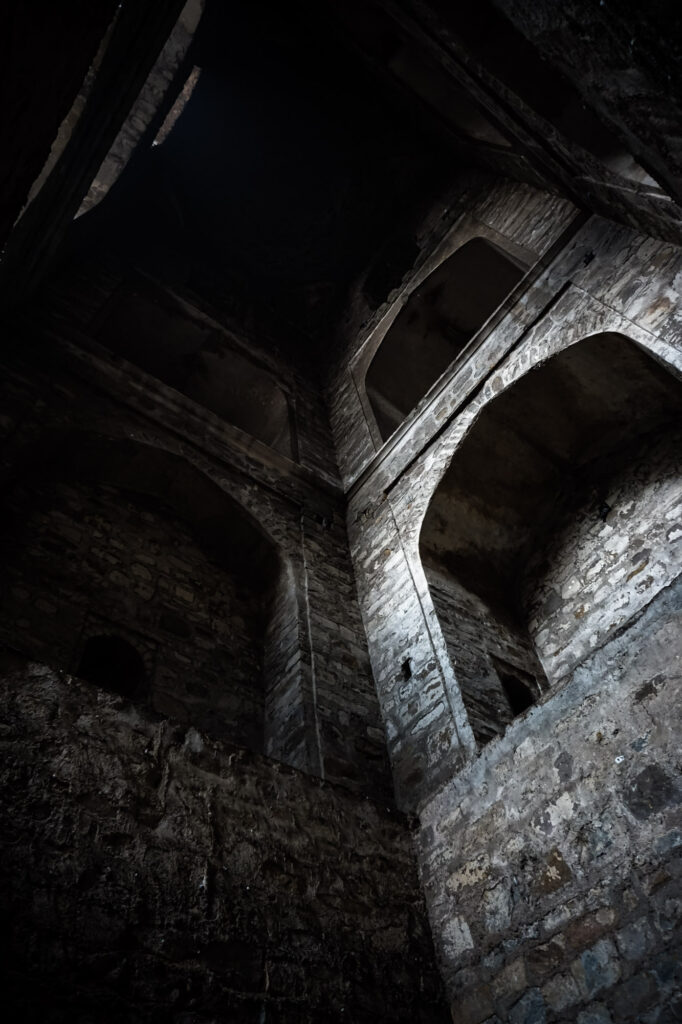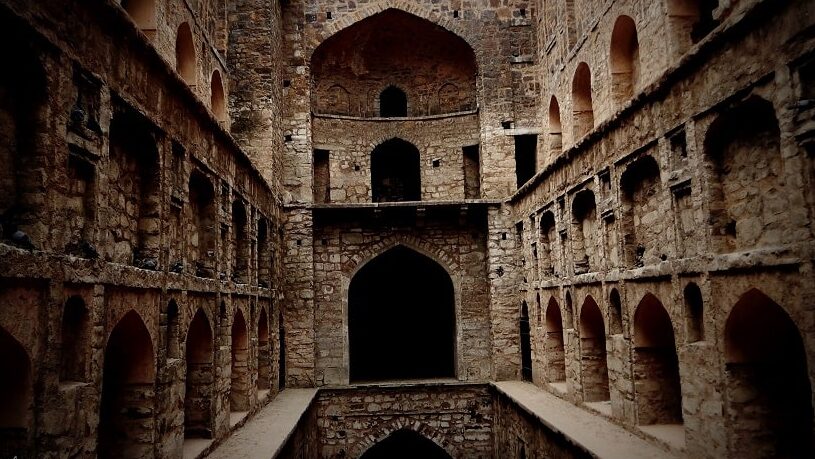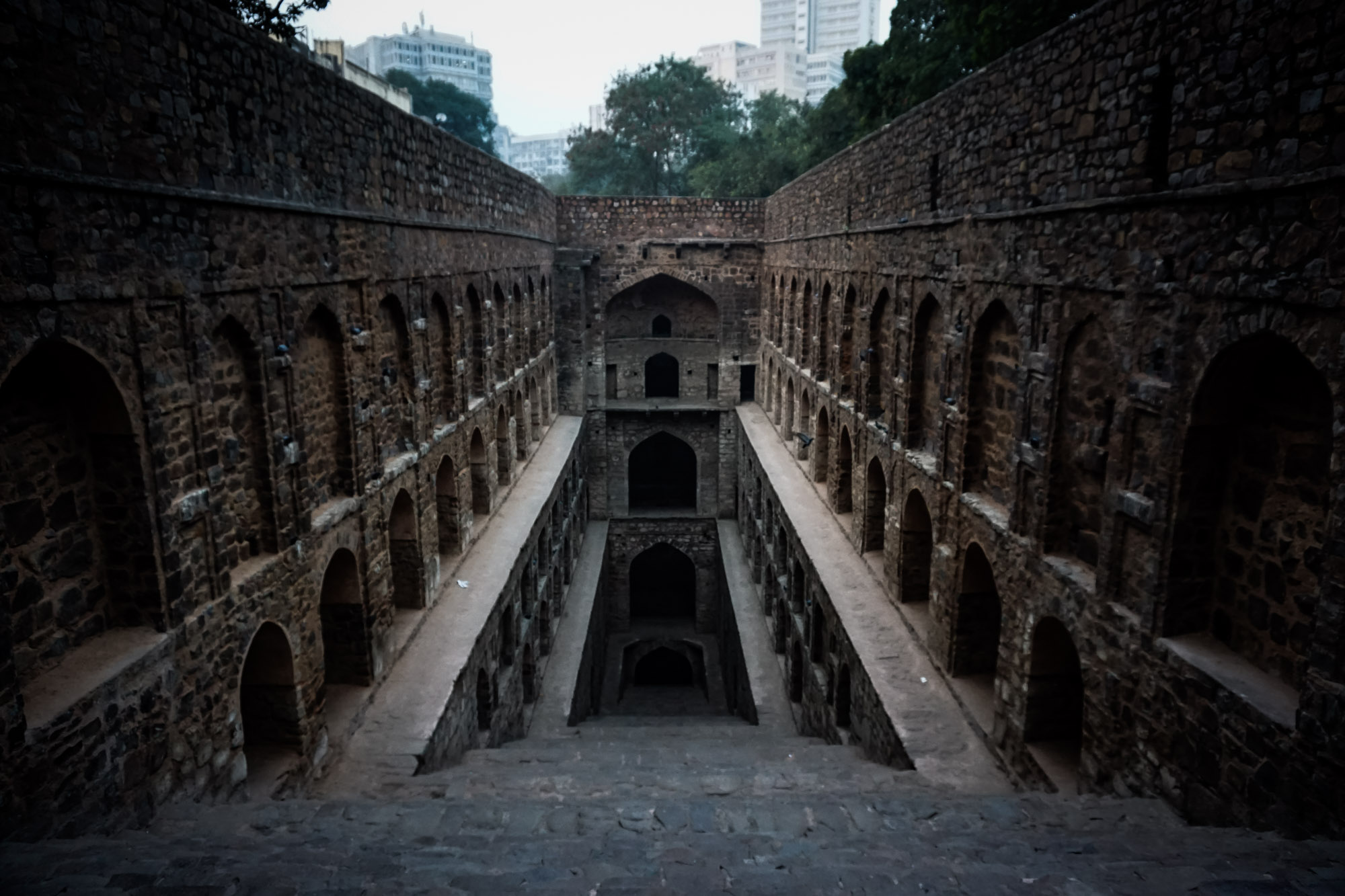A Haunted Tale of Mystery and Ancient Waters
Hidden amidst the bustling streets of Connaught Place, New Delhi, Agrasen Ki Baoli is a 14th-century stepwell that blends architectural splendor with chilling paranormal lore. This 60-meter-long, 15-meter-wide monument, with its 108 red sandstone steps, is a testament to India’s ancient water conservation ingenuity, yet it’s equally infamous as one of Delhi’s most haunted places. The legend of The Restless Souls of Agrasen Ki Baoli speaks of hypnotic black waters, invisible pursuers, and eerie whispers that lure visitors into its depths, earning it a spot among India’s top spooky sites. Protected by the Archaeological Survey of India (ASI), this stepwell draws tourists, photographers, and ghost hunters alike, all eager to unravel its mysteries. In this blog, we dive into the haunting tale of Agrasen Ki Baoli’s restless souls, explore its rich history, and reveal why this Delhi landmark is a must-visit for those daring to face its enigmatic aura.
Agrasen Ki Baoli: An Ancient Stepwell with a Haunted Legacy
Agrasen Ki Baoli, also known as Ugrasen Ki Baoli, is one of Delhi’s few surviving stepwells, located on Hailey Road near Connaught Place, close to Jantar Mantar. Believed to have been commissioned by Maharaja Agrasen during the Mahabharata era (circa 3000 BCE), the stepwell was likely rebuilt in the 14th century by the Agrawal community during the Tughlaq or Lodi dynasty, as evidenced by its Persian-style architecture. Spanning three levels with arched niches on either side, the 108 steps descend to a now-dry reservoir, once filled with water that served as a community hub for drinking, bathing, and rituals. The stepwell’s red sandstone walls, intricate arches, and a small three-sided mosque to the west showcase a blend of medieval craftsmanship and functionality.
Managed by the ASI under the Ancient Monuments and Archaeological Sites and Remains Act of 1958, the Baoli is open daily from 9 AM to 5:30 PM with free entry, though its steep steps and lack of wheelchair accessibility limit some visitors. Despite its historical significance and appearances in Bollywood films like PK and Sultan, the stepwell remains under-visited, partly due to its haunted reputation. The eerie silence, bat-infested niches, and pigeon droppings at the reservoir’s base create a spooky ambiance, amplified by tales of supernatural forces lurking within its depths.

The Legend of the Restless Souls
The restless souls of Agrasen Ki Baoli are central to its chilling lore, tied to the stepwell’s once-dark waters and mysterious past. Local legend claims the Baoli’s water, described as black and hypnotic, possessed a malevolent power that lured visitors to their deaths. In ancient times, the water was said to whisper to those who gazed into it, compelling them to step deeper and drown themselves in a trance-like state. These suicides, rumored to have occurred until as recently as 2007, are believed to have trapped the victims’ souls within the stepwell, their restless spirits now haunting its stone walls.
The most pervasive tale involves an invisible presence that follows visitors, especially as they descend the 108 steps. This entity, sometimes described as a djinn or malevolent force, grows more intense if one quickens their pace, creating a sense of being chased. Visitors report sudden slaps, eerie whispers, or a feeling of being watched, particularly in the lower levels where the light fades and the gurgling of pigeons and squeaking bats echo off the arches. Some believe these souls are tied to the Agrawal community’s rituals or the stepwell’s use as a refuge during invasions, where unceremonious deaths left spirits unrested. Others speculate the Baoli’s hypnotic water was a gateway for djinns, mythical beings from Islamic cosmology, who continue to guard its depths.
Paranormal Encounters at Agrasen Ki Baoli
Agrasen Ki Baoli’s haunted reputation is fueled by numerous accounts from visitors, locals, and paranormal investigators:
- Invisible Pursuers: Many report a persistent feeling of being followed or watched, especially at the lower steps, with the sensation intensifying if they run. A 2020 blog describes a visitor hearing footsteps behind them, only to find no one there.
- Hypnotic Water Tales: Though now dry, the Baoli’s water was once blamed for suicides, with legends claiming it hypnotized people into drowning. A 2016 article notes the last recorded attempt in 2007, though the shallow 5-foot depth raises doubts.
- Eerie Sounds: Whispers, slaps, and strange noises echo in the stepwell, attributed to restless souls or djinns. A 2024 Times of India piece mentions tales of sudden slaps startling visitors.
- Supernatural Presence: Some feel disconnected from the outside world at the Baoli’s base, with a 2021 paranormal investigator noting EMF spikes but no concrete evidence.
- Visual Anomalies: Visitors report seeing shadowy figures or orbs in photos, particularly near the locked gates at the reservoir’s base, rumored to be sealed due to past disappearances.
Paranormal investigator Jay Alani, who visited the Baoli five times, found no evidence of hauntings, suggesting the eerie feelings stem from its architecture and media hype. However, guards and locals, as cited in a 2025 Hindi news report, share tales of creepy experiences, reinforcing the stepwell’s mystique. The Baoli’s role in films like PK has boosted tourism, but its spooky reputation keeps many away after dusk.

Historical and Skeptical Perspectives
Agrasen Ki Baoli’s history is both illustrious and murky. Legend attributes its origins to Maharaja Agrasen, a contemporary of Lord Krishna, who founded the Agrawal community. However, no historical records confirm this, and archaeological evidence suggests a 14th-century rebuild during the Tughlaq or Lodi period, possibly by the Agrawal community honoring their ancestor. The stepwell served as a water reservoir, social hub, and ritual site, with its niches used for retreats or puja. Its proximity to Connaught Place, a modern commercial hub, contrasts with its ancient roots, adding to its enigmatic allure.
Skeptics challenge the haunted narrative:
- Architectural Effects: The Baoli’s deep, narrow design and stone walls amplify sounds like footsteps or pigeon coos, mistaken for paranormal activity. The fading light and isolation create a spooky ambiance.
- Media Hype: Stories of hauntings, amplified by blogs, YouTube vlogs, and films like PK, lack fact-checking. Alani notes that some locals and YouTubers may fabricate stories for attention.
- Psychological Factors: The feeling of being followed is common in confined spaces, and the Baoli’s reputation primes visitors for fear, creating a placebo effect.
- Suicide Myths: The hypnotic water tale is dubious, as the reservoir’s 5-foot depth makes drowning unlikely, and no verified suicide records exist.
- Cultural Beliefs: Tales of djinns align with Delhi’s “City of Djinns” moniker, but lack concrete evidence, rooted instead in folklore.
Despite skepticism, the consistency of visitor experiences, from guards to tourists, fuels belief in the restless souls. The ASI’s restriction on nighttime access further stokes speculation, though officially for safety.
Agrasen Ki Baoli Today: A Haunted Tourism Gem
Agrasen Ki Baoli remains a top Delhi attraction, accessible via Rajiv Chowk Metro Station (1 km) or buses to Connaught Place (2 km). Located 14.5 km from Indira Gandhi International Airport and 2.8 km from New Delhi Railway Station, it’s open daily from 9 AM to 5:30 PM with free entry, though photography is popular, and videography may require ASI permission. Limited street parking is available on Hailey Road, and nearby hotels like The Imperial or Zostel Delhi cater to visitors. The stepwell’s photogenic arches and historical charm make it a favorite for Instagram and film shoots, yet its haunted tales deter some, especially after sunset.
Nearby attractions like Jantar Mantar, India Gate (2 km), and Connaught Place’s restaurants complement a visit, offering a mix of history and modernity. The Baoli’s inclusion in haunted lists, alongside Jamali Kamali Mosque and Feroz Shah Kotla, draws adventure-seekers, amplified by X posts and media like a 2020 India.com feature.
Why Visit Agrasen Ki Baoli? Tips for Travelers
Agrasen Ki Baoli blends ancient architecture, cultural history, and paranormal intrigue, making it a top Delhi destination:
- Best Time: Visit from October to February for pleasant weather, enhancing the eerie vibe. Early mornings or late afternoons offer softer light for photography.
- Getting There: Take the Blue/Yellow Line Metro to Rajiv Chowk (1 km, ₹20–30 by auto) or a cab from the airport (14.5 km, ₹300–400). Buses to Connaught Place stop 2 km away.
- What to See: Explore the 108 steps, arched niches, and mosque. Pair with Jantar Mantar (500 m) or India Gate (2 km) for a full day.
- Ghost Hunting: Bring a camera for orbs or shadows, but stay in groups and avoid descending alone. Respect ASI’s 5:30 PM closure to avoid fines.
- Safety: Wear sturdy shoes for steep steps, and be cautious of pigeon droppings. The area is safe but crowded with couples, not ideal for families.
- Cultural Respect: Honor the Baoli’s Agrawal heritage and avoid littering, as it’s a protected monument.
Conclusion: Dare to Face the Restless Souls?
The Restless Souls of Agrasen Ki Baoli weave a chilling narrative of hypnotic waters, invisible pursuers, and ancient mysteries, transforming this Delhi stepwell into a paranormal hotspot. Whether these spirits are djinns, trapped souls, or mere echoes of folklore, the Baoli’s eerie allure is undeniable. As you descend its 108 steps, will you feel the gaze of unseen eyes or hear the whispers of the past? Visit Agrasen Ki Baoli to uncover its secrets—but tread carefully, for the restless souls may still linger in its shadows.
Have you explored Agrasen Ki Baoli or heard its haunted tales? Share your experiences in the comments, and subscribe for more spooky stories from India’s haunted heritage!
Disclaimer: The Restless Souls of Agrasen Ki Baoli are based on folklore and anecdotal reports, with no definitive evidence of paranormal activity. Approach with curiosity and respect for Delhi’s cultural and historical legacy.
